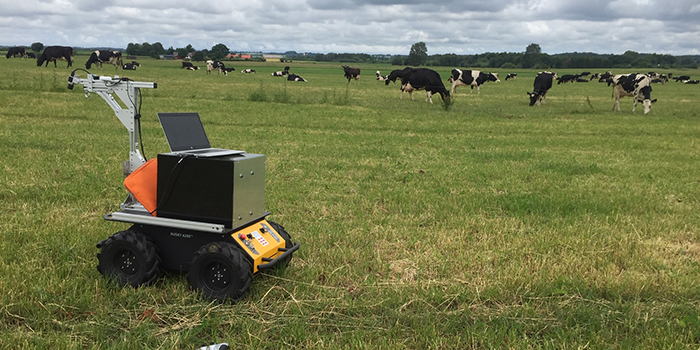A large image database forms the basis for the training of a small robot which—in future—will remove unwanted weeds from organic pastures.
In future, a robot the size of a large lawnmower will help organic farmers remove dock weeds from their pastures. The dock is a big problem because it takes up space from the plants in the field that give the cows the best nutrition.
It may sound like a small task, but it requires a lot of effort to get the robot to recognize the weeds. On the face of it, it is—in fact—not so easy to distinguish a green weed from the grass in the field.
“Initially, we took a large number of photos at three organic farmers. They were photos of the dock plant and its leaves as well as of different pastures for use as background,” explains Ronja Güldenring, DTU Electrical Engineering, who heads the project.
“The next step has been to make a large number of photo combinations so that the docks appear with different backgrounds. This may be photos taken in different fields, different times of the day, different times of the year, etc.,” says Ronja Güldenring.
The robot must be robust
The goal of the first months of photography work has been to create a database of several thousands of different images with combinations of docks and backgrounds. The large quantity of photos is necessary to have a sufficient basis for training the robot in recognizing and locating the weeds under very different conditions.
“For example, a rain shower or morning dew means that there may be water drop-lets on the dock leaves that give unwanted camera reflections. The robot must also be able to take this into account,” says Ronja Güldenring.
Ronja Güldenring will now start training the robot so that—with the help of a camera mounted on top and another mounted beneath the robot’s ‘shell’—it will be able to recognize and locate the weeds in a pasture. When this has been successfully achieved, the robot will be supplemented with instruments that can destroy the dock by means of either laser or electrocution-based techniques. However, this will not be until in 2022. Until then, Ronja Güldenring has published all her image data—so that other researchers will be able to use them in their work—as it is both expensive and time-consuming to collect such large data sets.
New technology makes robot possible
The organic dairy farmers who have made pastures available for the photography are convinced that the robot will be a good thing. This pleases Ronja Güldenring, who hopes that the project can contribute to the green transition by allowing even more conventional dairy farmers to cultivate their fields organically in the future.
The overall project manager, Lazaros Nalpantidis, is also positive about the possibilities. “The agricultural sector has already come far with the use of autonomous systems, which is—not least—connected with fewer and fewer people being employed in the sector.”
Lazaros Nalpantidis stresses in this connection that a couple of new technological advances have made the development of the new robot possible.
“The introduction of the 5G network has made wireless connections more stable, and—with access to data from the new Galileo satellites—it has also become possible to establish a precise positioning of the weeds within a few centimetres against previous deviations of up to several metres,” says Lazaros Nalpantidis.
The new robot is being developed in an EU project that includes several partners—including Wageningen UR in the Netherlands—which is regarded as one of the world’s leading universities in agricultural research. In the course of 2022, DTU will work closely with the other project partners to combine the various technologies for use in the robot, which will then be tested further.
